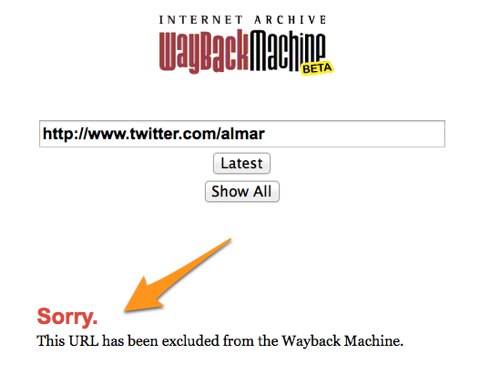October 15, 2012
The Fragility of the Web
Do you remember what your first Facebook or Twitter profile page looked like? What was your avatar? Where you on MySpace when it was around? What was your first presence on the web at all, and is it still visible?
The answer to all these questions is probably 'NO'.
And if you do remember, you're not very likely to have any (visual) archive of it. The actual data you posted or shared might still be around. The Archive.org organization might have saved your site, but not all of it and definitely not your profile on a social network (or does it?).

The point is that the Internet is still very fragile, like for example the first pottery, so it's first manifestations are not likely to last. But it is part of your personal and our collective history. Something that is worth preserving.
Rhizome.org is focused on preserving digital art: "The mission of the ArtBase is to provide free, open, and permanent access to a living and historic collection of seminal new media art objects." They keep these works running, so you can actually still access and see them. Even after Windows update #300.001. But what about the rest (of us). Our trivial profile pages and updates provide a context to these works, and the times we live in.
So we have to take our digital preservation in our own hands by taking screenshots, writing down bookmarks and backing up (micro)blog entries and social media posts.
Couldn't be bothered? Imagine what cleaning out your old attic will feel like if you don't...
Posted by Almar at 03:09 PM
July 26, 2011
Social Mania
Google Plus just reached 10 million users in a few weeks. The online socialites were craving for an invite, just not to miss out on a sharing opportunity. And all this while lots of people are still 'afraid of sharing' and privacy is still an issue; even in higher Circles (be sure to check your photo settings when building a G+ profile, or your snapshot might just end up on a postcard stand).
Also it's Yet Another Social Network, where it's easy to setup a profile, harder to continuously share relevant information and tough to get and keep a following. It's a Catch-22: you have to be in to be credible and once you are in, you can only lose credibility by being too involved or not involved enough. And this applies to all the currently 'hot' social networks.
My best advice: stay in motion, like these log-rollers, and outlast the competition (if only for a few moments).

Posted by Almar at 04:11 PM | Comments (0)
September 17, 2009
Art curation for the corporate website?
Yesterday I added a digital artwork to my corporate site (see www.virvie.com under 'Destination' and scroll down a little) and actually found it a little hard to do. I see it as decoration of my virtual headquarters, but positioning the piece wasn't all that obvious.
The issue, in comparison, is not the color on the walls or the decorative ornaments on the building, but rather the paintings or sculptures that are added later.
So it's not the 'interior decoration', because that is realized by visual design (determining the colour of the 'curtains and the carpet') and interaction design (positioning the 'table and chairs' so you can sit and walk around comfortably). But, then, what is it? And is it something that can and should be designed for (similar to planning high and wide walls for large paintings in the entrance halls of office buildings)?
Posted via web from VIRVIE's ongoing discussion
Posted by Almar at 11:40 AM | Comments (0)
July 28, 2009
Closed source concepts?
It might by a tricky question in the open source era, but is it reasonable to register website concepts? In the TV and movie business they use file-reg.com to register show formats in order to protect and trade them. In case of a TV formats they depict the conception process, the show name, a set sequence of events within the show etc.
In the website business a lot of ideas get 'borrowed', and I wonder if this (still) is the favourable situation...
Posted via web from VIRVIE's ongoing discussion
Posted by Almar at 06:02 PM | Comments (0)
June 08, 2009
100% read/write?
When I finally got round to taking a closer look at Google Wave, I was very pleased with the potential that is created by rethinking a common thing like e-mail. I was struck though by the following comment in the presentation (at 11m48s): ".. with Google Wave you spend 100% of your time either reading or writing". Because messages are instantly posted by the system you no longer have to wait for the other person to finish, which is good, but this opposite doesn't sound quite right either. I don't mind being 100% online, and I can't wait to exploit the potential of Google Wave (and a definite farewell to MS Office?), but I would like to see some kind of pleasurable 'idle'-mode built in. Is it possible to have an in-between state of reflection next to reading an writing online?
Posted via web from VIRVIE's ongoing discussion
Posted by Almar at 10:30 AM | Comments (0)
May 14, 2009
Room for the non-functional?
I like to incorporate non-functional elements to my webpresence concepts. And by non-functional I mean functionality (not just graphical design) that has no immediate purpose, other than to inspire or provide diversion. I see it like art on a wall and therefore essential. There is a lot of digital art out there already, but hardly ever part of a mainstream (corporate) website. Do you feel there is or should be room for that?
Posted via web from VIRVIE's ongoing discussion
Posted by Almar at 05:49 PM | Comments (0)